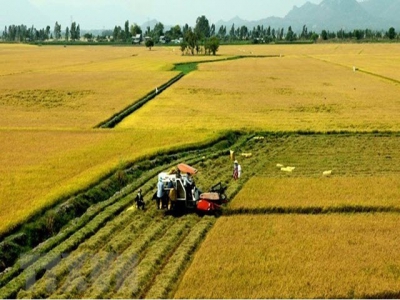Enhancing added value for Vietnamese agricultural products

Vietnam’s agricultural products have been exported to more than 180 countries and territories worldwide. (Illustrative photo: VNA)
At a national conference to discuss solutions to promote business investment in the agricultural sector, recently held in Da Lat city, in the Central Highlands province of Lam Dong, Prime Minister Nguyen Xuan Phuc ordered the agricultural sector to reach the top 15 most developed countries in the world in the next 10 years, with its agricultural product processing ranked in the top 10.
The Government leader expressed his hope that, in the future, Vietnam would soon become a deep processing centre of world agriculture and a logistic hub of global agricultural trade.
The confidence and expectation of the Prime Minister in agriculture is not without foundation. Over the past 10 years, agriculture has maintained steady growth and development. Particularly since 2013, the agricultural sector has implemented restructuring in accordance with the Government's decision and has made radical changes in the direction of shifting from quantity to quality and added value. The total agricultural, forestry and fishery export revenue in the past 10 years (2008 - 2017) reached US$261.28 billion, an increase of 9.24%. In 2017, the figure was estimated at US$36.52 billion, an increase of US$20.05 billion compared to 2008. It is expected that in 2018, the export revenue of agriculture, forestry and aquaculture will reach US$40 billion. Vietnam’s agricultural products have been exported to more than 180 countries and territories worldwide, ranking second in Southeast Asia and 16th in the world, contributing to creating foreign currency revenue and reducing trade deficit for the whole country.
Apart from the efforts made by the whole agricultural sector, the aforementioned results are attributed to the due attention given by the Party and the Government. In just the two years of 2016 and 2017, the Government and the Prime Minister issued at least 10 decrees on mechanisms and policies to create favourable conditions for enterprises to change their production models, promote value chains, and build the brands of Vietnamese agricultural products in the international market. Most recently, Decree No.57 of the Government issued in April, 2018, on the mechanisms and policies to encourage enterprises to invest in agriculture and rural areas is expected to quickly create more positive impacts and promote the development of domestic agriculture.
However, in realising the Prime Minister’s instruction, the agricultural sector may encounter potential constraints due to backward agricultural production, particularly in post-harvest production and processing. It requires more investment from enterprises. At present, approximately 49,600 enterprises nationwide have invested in agriculture, accounting for 8% of the total number of enterprises operating in the country, and creating more than 4.5 million jobs for rural workers. More than 95% of enterprises operating in agricultural sector work on a small or micro scale.
At present, it is necessary for the agricultural sector to continue to focus on implementing policies to support and encourage the development of deep-processing industry and the processing of instant food products, while promoting mechanisation to reduce post-harvest losses and production costs, and creating high value added agricultural products.
Furthermore, the Ministry of Planning and Investment should soon issue a circular on guiding the implementation of Decree No.57 so that enterprises investing in agriculture and rural areas will have the right to enjoy the preferential policies of the Government. The Ministry of Trade and Industry should finalise the decrees related to trade activities, especially Decree No.159 on rice export, and links between the supply and demand of domestic and foreign markets for Vietnamese agricultural products. The Finance Ministry needs to revise the Decree No. 55 on credit policies for agricultural and rural development in the direction of raising lending rates and extending credit policy beneficiaries to create favourable conditions for enterprises to access loans to invest in the development of agricultural commodity production.
Có thể bạn quan tâm
 Building brand name for Vietnam’s coffee
Building brand name for Vietnam’s coffee Vietnam is one of the largest coffee producers in the world, earning more than 3 billion USD from the export of coffee bean each year
 Where is Vietnam’s hi-tech agriculture?
Where is Vietnam’s hi-tech agriculture? IoT and blockchain application in agricultural production in Vietnam remains modest, while other high technologies are used by only 10 percent
 Vietnam’s tea exports still in downtrend
Vietnam’s tea exports still in downtrend Vietnam earned 109 million USD from exporting 67,000 tonnes of tea in the first seven months of 2018, a year-on-year decrease of 12.9 percent in volume.